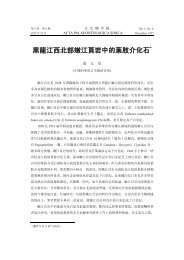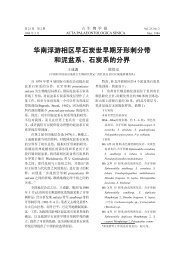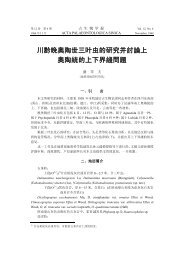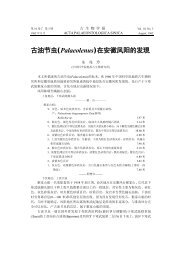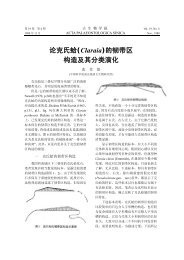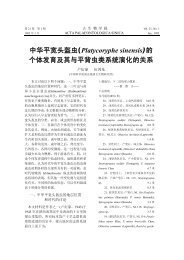ephedroids from the Early Cretaceous Yixian Formation in Liaoning ...
ephedroids from the Early Cretaceous Yixian Formation in Liaoning ...
ephedroids from the Early Cretaceous Yixian Formation in Liaoning ...
You also want an ePaper? Increase the reach of your titles
YUMPU automatically turns print PDFs into web optimized ePapers that Google loves.
258 C. Ryd<strong>in</strong> et al.: <strong>Cretaceous</strong> <strong>ephedroids</strong> <strong>from</strong> Ch<strong>in</strong>a<br />
Table 3. Fossils with aff<strong>in</strong>ity to Ephedra<br />
Reference Location Age Description Comments<br />
Plant with an ephedroid habit,<br />
but is <strong>in</strong>terpreted as hav<strong>in</strong>g<br />
alternate branch<strong>in</strong>g, which is<br />
o<strong>the</strong>rwise unknown <strong>in</strong> <strong>the</strong><br />
Reproductive<br />
shoot<br />
Dalazi <strong>Formation</strong>, Ch<strong>in</strong>a <strong>Early</strong><br />
<strong>Cretaceous</strong><br />
Alloephedra x<strong>in</strong>gxuei<br />
(Tao and Yang 2003)<br />
Gnetales.<br />
Reproductive Ephedroid plant similar to<br />
shoot<br />
Liaoxia, but appears to have<br />
longer or dist<strong>in</strong>ctly po<strong>in</strong>ted<br />
cone bracts.<br />
Reproductive Well-preserved Ephedra-fossil,<br />
shoot<br />
with vegetative and reproductive<br />
parts <strong>in</strong> connection. The large<br />
‘‘mature’’ cone is detached and<br />
could potentially belong to ano<strong>the</strong>r<br />
species.<br />
Coalified seeds Well-preserved Ephedra seeds<br />
with anatomical details and <strong>in</strong><br />
situ pollen.<br />
Coalified seeds Well-preserved Ephedra seeds<br />
with anatomical details and <strong>in</strong><br />
situ pollen.<br />
Coalified seeds Well-preserved ephedroid seeds<br />
with anatomical details and <strong>in</strong><br />
situ pollen.<br />
Reproductive The material belongs to two se-<br />
shoots<br />
parate species, previously described<br />
as Liaoxia chenii and<br />
Eragrosites changii (Cao et al.<br />
1998).<br />
Reproductive Similar to <strong>the</strong> ‘‘potamogeton-like<br />
shoot<br />
spikes’’ <strong>from</strong> Manlej (Krassilov<br />
1982). No leaves or nodes preserved.<br />
Cone (spike) with bracts<br />
at ‘‘nodes’’, separated by<br />
‘‘<strong>in</strong>ternodes’’.<br />
Manlaj, Mongolia <strong>Early</strong><br />
<strong>Cretaceous</strong><br />
‘‘Cyperacites sp.’’ plate 20,<br />
figs. 240–243<br />
(Krassilov 1982)<br />
<strong>Yixian</strong> <strong>Formation</strong>, Ch<strong>in</strong>a <strong>Early</strong><br />
<strong>Cretaceous</strong><br />
Ephedra archaeorhytidosperma<br />
(Yang et al. 2005)<br />
<strong>Early</strong><br />
<strong>Cretaceous</strong><br />
Potomac Group, North<br />
America<br />
Ephedra drewriensis<br />
(Ryd<strong>in</strong> et al. 2006)<br />
Buarcos, Portugal <strong>Early</strong><br />
<strong>Cretaceous</strong><br />
Ephedra portugallica<br />
(Ryd<strong>in</strong> et al. 2006)<br />
Buarcos, Portugal <strong>Early</strong><br />
<strong>Cretaceous</strong><br />
Ephedrispermum lucitanicum<br />
(Ryd<strong>in</strong> et al. 2006)<br />
<strong>Yixian</strong> <strong>Formation</strong>, Ch<strong>in</strong>a <strong>Early</strong><br />
<strong>Cretaceous</strong><br />
Ephedrites chenii (Guo and Wu 2000).<br />
(Synonym of Liaoxia chenii<br />
Cao et al., 1998)<br />
Ephedrites? elegans (Sun et al. 2001) <strong>Yixian</strong> <strong>Formation</strong>, Ch<strong>in</strong>a <strong>Early</strong><br />
<strong>Cretaceous</strong>




